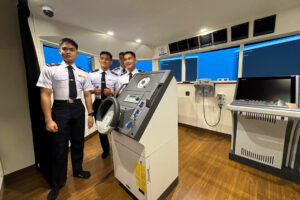(Part 1)
At a recent graduation ceremony of the NYK-TDG Maritime Academy (NTMA), located at the Carmelray Industrial Zone in Canlubang, I felt very proud of Filipino manpower, despite recent breast-beating about the poor state of Philippine education.
NTMA is a maritime academy founded through a partnership between Nippon Yusen Kaisha (NYK) — one of the world’s largest shipping companies based in Japan which was established in 1885 — and the Transnational Diversified Group, a Filipino-owned business conglomerate established in 1976. It is a boarding “officer school” offering maritime education (e.g., BSMT, BSMarE), with guaranteed employment aboard NYK vessels after graduation.
What impressed me was to see the parents of the graduating officers. They were clearly from very low-income households coming from some remote regions of the Philippines, especially the Cordillera region or Mountain Province. Listening to some of the speeches delivered by some of the graduating officers and the very polished manner with which all the graduates conducted themselves, both during the commencement exercises and the reception that followed after, I am convinced of the great potential of our human resources, despite all the challenges that our educational system is currently facing.
As long as we continue mobilizing the resources and energy of the private sector, we can still address the limitations of our public education system and not give up on our existing labor force, no matter how poor the quality of education they might have received in our public schools. Given remedial measures by private enterprises like NTMA, the handicap suffered by products of our less-than-ideal public educational system can be overcome because of innate talent, especially of our people coming from the lower income groups. I saw that very clearly among those who graduated in that officers training program in Canlubang. The Valedictorian who spoke can hold a candle to any graduate of UP, Ateneo, or La Salle.
In fact, Filipino seafarers in general (not only officers) make up the largest percentage of maritime labor in the world today. As of recent reports, 400,000 Filipinos are deployed annually, accounting for about 25% of the world’s 1.6 million seafarers. Around 90% of world trade is carried by sea. Filipino seafarers crew tankers, bulk carriers, container ships, cruise ships, and more — ensuring supply chains operate smoothly. Filipino seafarers send home billions of dollars in remittances annually.
Filipino seafarers serve in both officer and ratings positions. A good number of them, especially in ships owned by Japanese companies, have become deck officers (navigation, safety, and cargo handling) as well as engine officers (machinery operation and maintenance). I know of graduates of NTMA who have risen to the ranks of Captain (Master) or Chief Engineer, managing entire ships and multinational crews. Given the serious depopulation and ageing problem of Japan (and some seafaring countries in Europe) more Filipinos can aspire to rise to these high positions in international shipping.
Of course, the vast majority of Filipino seafarers are in support roles like able seamen, oilers, cooks, stewards, and hospitality workers in cruise ships (e.g., musicians and other entertainers). Filipinos are in big demand in the global seafaring industry because they can be fluent in English, the global language of shipping; they are well-trained in such schools as NTMA and the Philippine Merchant Marine Academy (PMMA), and others; they are culturally adaptable and hard working, oftentimes praised for discipline, professionalism, and cheerfulness. The International Maritime Organization (IMO) and global shipping companies recognize Filipino seafarers as essential maritime workers, especially highlighted during the COVID-19 pandemic when crew changes became difficult.
Naturally, not everything is a bed or roses for Filipino seafarers. Their job security is often short-term. Long periods away from home, isolation on long trips especially in oil tankers, and stress from work can take a toll on both physical and mental health. They also face the risks of maritime incidents and piracy, depending on routes and ship types. These risks have become more pronounced in recent times because of the Russian-Ukraine War and the conflicts in the Middle East. There is also the need for constant upskilling and reskilling because of automation and digitalization.
With the help of ChatGPT, I was glad to find out that there are other top maritime academies in the Philippine like NTMA. There is the government-run PMMA, located in San Narciso, Zambales, which offers a BS in Marine Transportation and Marine Engineering. Their cadets are considered midshipmen of the Armed Forces of the Philippines. I can identify with them because during my college days at De La Salle University, our military training was with the Naval ROTC and we had to spend one whole summer on a patrol craft (from the Second World War) guarding the seas around Polillo Island and Bicol against smugglers.
Then there is the Maritime Academy of Asia and the Pacific (MAAP), a private institution founded by the Associated Marine Officers’ and Seamen’s Union of the Philippines (AMOSUP), that offers BS degrees in Marine Transportation and Marine Engineering, among other maritime related programs. It is located in Mariveles, Bataan, and has highly modern training facilities that are up to international standards. It is worth noting that Bataan will become even a more important naval, transport, and logistics hub once the bridge connecting Cavite to Bataan through Corregidor is completed. This game-changing infrastructure project received special mention from President Ferdinand Marcos, Jr. in his fourth State of the Nation Address on July 28.
Then there is the John B. Lacson Foundation Maritime University (JBLFMU) located in Iloilo City, the logistics hub of the Visayas. It offers Marine Engineering, Marine Transportation, Customs Administration, etc. Yearly, it enrolls some 11,000 students and has campuses in other cities and Visayas towns like Bacolod, Molo, and Arevalo. It is a private institution and is one of the largest maritime schools in the entire country. The City of Iloilo in the province of Panay is well known for having produced the largest number of seafarers from the Philippines. There is a long-standing tradition among Ilonggo families to produce seafarers among the males in their families.
Others are the Asian Institute of Maritime Studies in Pasay City, also private, offering BS Maritime Transportation, Maritime Engineering, and BS Naval Architecture. As regards the last-mentioned degree, it is worth noting that there have been talks recently about countries from the Scandinavian region, Japan, and South Korea on establishing ship-building facilities in the Philippines to take advantage of our still young and growing population.
There are also other private universities and technical institutes that offer courses in marine engineering and marine transport. These are the Technological Institute of the Philippines in Manila and Quezon City; the University of Cebu – Maritime Education and Training Center; DMMA College of Southern Philippines in Davao City; Northern Philippine College for Maritime, Science and Technology; and the PMI Colleges (formerly the Philippine Maritime Institute), one of the oldest maritime schools in the Philippines, that has campuses in Manila, Quezon City, and Tagbilaran City. Enrolment in these maritime academies can range from 5,000 to 11,000.
Considering the irreversible ageing of all the maritime powers of the world today, it would be wise for private for-profit schools to follow the lead of these existing maritime academies and add to their curricular offerings courses in maritime studies. I am referring to very successful for-profit private universities like the PHINMA Education schools, the National University, and the Far Eastern University, among others. We still will enjoy another 20 to 30 years during which we will have a young and growing population, despite the less than replacement birth rate of 1.9 that we have already reached.
(To be continued.)
Bernardo M. Villegas has a Ph.D. in Economics from Harvard, is professor emeritus at the University of Asia and the Pacific, and a visiting professor at the IESE Business School in Barcelona, Spain. He was a member of the 1986 Constitutional Commission.
bernardo.villegas@uap.asia

